|
Because of the wide
variety of magic lanterns it is almost impossible to classify them in
categories. There will always be borderline cases and exceptions and we
always could class many of them under several groups. Besides many models were launched in several sizes and in that case we could classify the smaller ones as toy lanterns and the bigger ones as parlour lanterns. Nevertheless we will have a try. Toy lanterns or Children's lanterns. These magic lanterns have small dimensions, have a plain construction and were cheap. They originally were provided with a candle or a small oil lamp as source of light. They are only suitable for showing small magic lantern slides of about 2 till 4 cm wide. Parlour lanterns. These lanterns are already a bit larger, have a more solid construction and are consequently more expensive. Because of the larger and more dangerous oil lamps they must not be considered as a toy. Larger lanterns. The kind of magic lanterns that were used to present lectures in large rooms and for teaching students at schools or university. Plural lanterns. These lanterns were mostly made of wood and brass and consisted of two or three single lanterns that were placed on top of each other or sometimes placed side by side. Thus amazing effects could be performed, like dissolving views. Special lanterns. By this we understand among other things the magic lanterns that are able to show not alone glass magic lantern slides, but also films or non-translucent cards or films, like the cinematographs and episcopes. Also remarkable lanterns like the lamposcope and the street lantern are classed here. Fancy lanterns. An exclusive category is build by magic lanterns that are not recognisable as a magic lantern at first sight because they are disguised as something else, like a Buddha, a mosque or an Eiffel tower. |
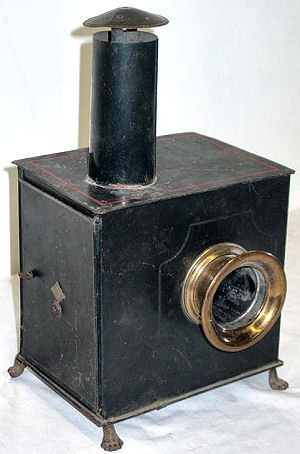 |
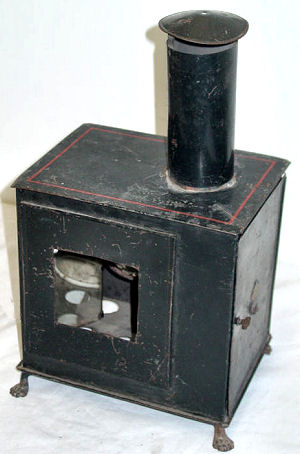 |
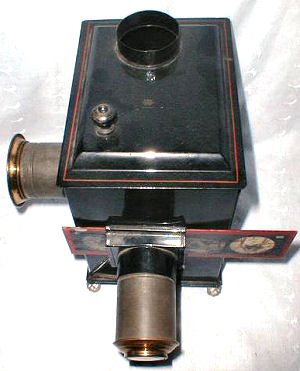 |
Bing episcope (above)
and a combined episcope/magic lantern (left), a so called epidiascope.
(see also:
Episcopes) |
|
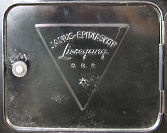 The company of Ed. Liesegang made this type of large Episcope, the so called 'Janus' around 1925 in Düsseldorf, Germany. An improved version is the 'Trajanus', equipped with two lamps in stead of one. The object or the image is situated on a metal shield at the bottom of the lantern, that can be moved up and down by means of a lever system that always keeps the shield in a horizontal position. |
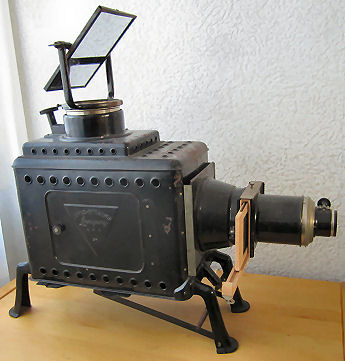 |
|
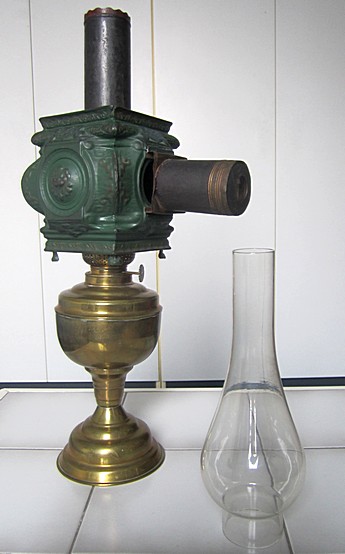 |
The Lampascope is a magic lantern
that did not need the purchase of a particular lamp because it simply
could be placed upon a tall oil lamp that could be found in every
household in those days. To prevent the magic lantern to turn over, the
reflector inside the lantern was filled up with sand to make it heavier.
This way it functioned as a counterweight for the lens tube and lenses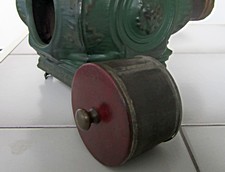 This Lampascope Carrée was made around 1880 by the French brothers Lapierre. |
|
|
While almost all magic lanterns are
only suitable for showing long or square magic lantern slides also magic
lanterns that can handle round, disc shaped magic lantern slides exist. This lanterns is made by E.P. (Ernst Plank). The disc below is made by J.S. (Jean Schoenner). |
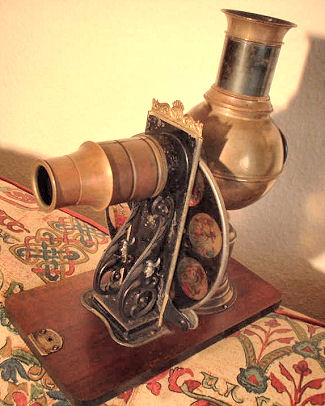 |
|
 |
||
|
The Cinematograph was the
changeover from the magic lantern that usually produced only static
images, to the film projector with its moving images on the screen. In
the beginning only very short films were used. Start and end were glued
to a loop, resulting an endless repetition of the images. Often used
subjects were: a dancing clown, a steam train riding over a bridge, a
juggler juggling his balls, and so on. Subsequently also longer films on
reels were used. The passed film was not caught by a second reel but
simply landed on the floor. |
||
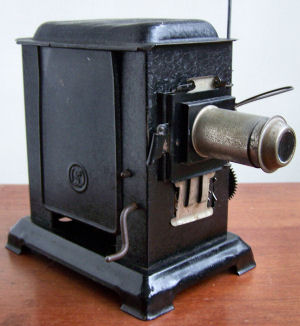 |
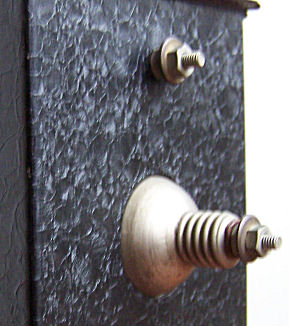 |
|
|
Nice toy cinematograph with
battery and flashlight bulb. Marked
Leonhard Müller, Nuremberg, Germany. Made of tin with a hammer stroke lacquer. Socket for flashlight bulb is fixed up in the back. Flat roof, not a chimney needed. Upwards hinged door in side wall with a pressed in trade mark 'LM'. Film movement by means of a Maltese Cross inside the lamp house. Guidance for the film. Suitable for long magic lantern slides of 3 cm wide. Sizes c.: long 19 cm, wide 10 cm, height 14.5 cm excl. film holder. |
||
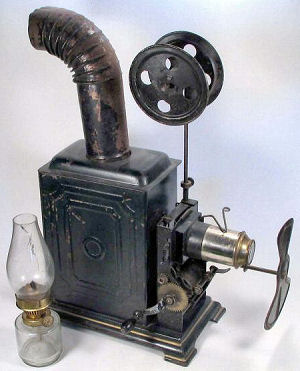 |
Cinematograph made by the German
manufacturer Leonhard Müller (LM). Rather special is the shutter that turns around in front of the lens. At most cinematographs the shutter is placed between the condenser and the film strip. (see also Cinematographs) |
|
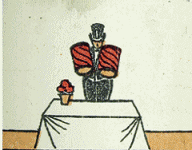 Endless film strip, displayed by a Cinematograph. |
||
|
This
cinematograph from Ernst Plank
(E.P.) is made of Japanned tin and mounted on an oak base. At the front
of the lamp house a small metal mark shield is fitted. A large fly wheel at
the side drives the film movement by way of a strap, disc, bar, worm
wheel and pins. The front part with the optical system is removable and can be exchanged by a simple front part complete with lens tube holder, that makes the cinematograph to a normal magic lantern for magic lantern slides. The lantern measures 36 x 20 x 36 cm. |
 |
|
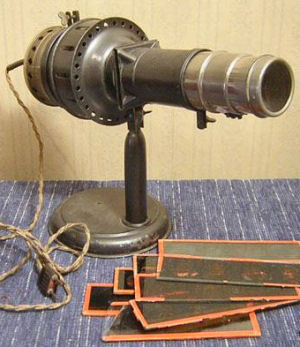 |
Street lantern. This kind of magic lantern was in use for the projection of advertising slides on the pavement or a wall opposite the street because of the very long focal distance. This did not last a long period because it was prohibit by the police because the shows caused traffic jam, accidents and disturbances. | |
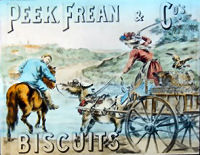 |
||
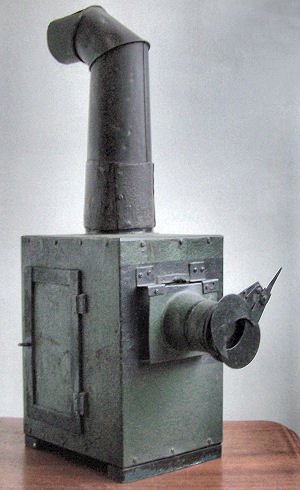 |
 |
|
|
Do-it-yourself magic lantern. We don't know when and by whom this do-it-yourself lantern was built and whether it was used only in the living room, or for performances for a broad public. The robust sizes and the material that was used (solid metal plate) seems to indicate a professional use. Two, half-moon shaped discs in front of the lenses, make it possible to fade-in and fade-out the pictures. |
||
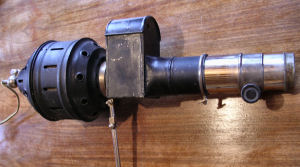 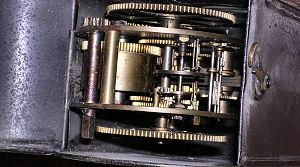 |
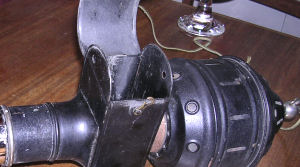 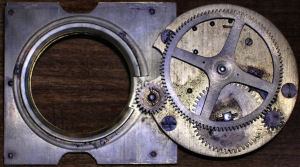 |
|
|
Rare street lantern with a built-in
clock mechanism. Unfortunately the glass slide that was driven on is no
more. Probably is was a multi coloured glass that projected colour
changes or chromatropic effects on a wall or floor. |
||
| Select another sort of magic lantern by clicking one of the images below: | |||||
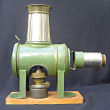 |
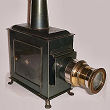 |
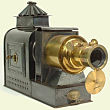 |
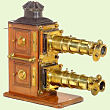 |
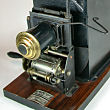 |
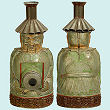 |
| |
©1997-2021 'de Luikerwaal' All rights reserved. Last update: 10-05-2021. |
|